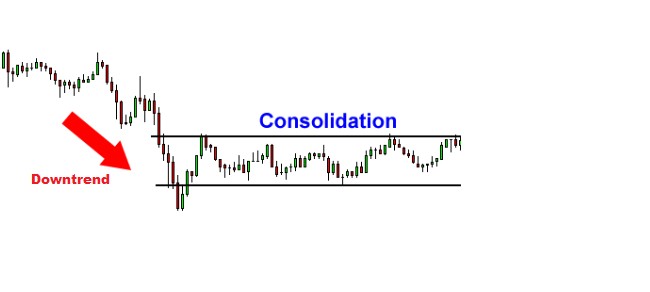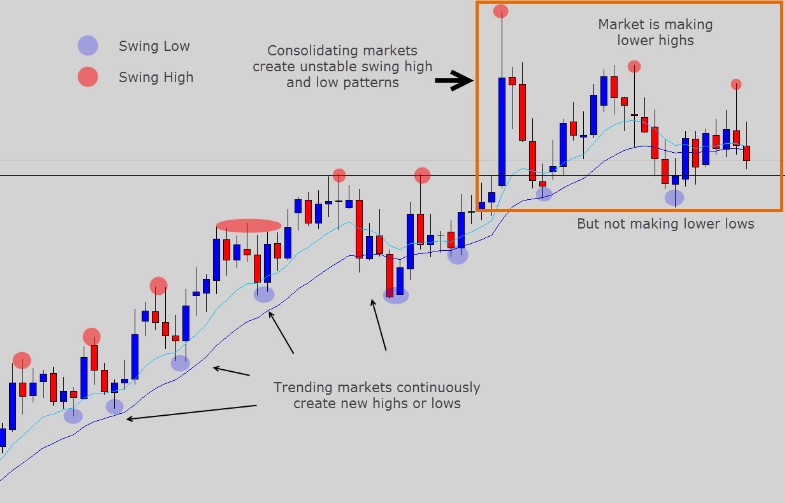What is market consolidation?

What is market consolidation? Consolidation is a term in technical analysis, both foreign exchange and stock, to describe a flat market condition.
When the market is in a consolidation phase, the price movement does not change in large numbers. It only moves up and down in a low range.
If we draw a rectangular box, the price is between the peaks and the valley of the box. In other words, the market pauses for a while before continuing the trend. Often traders are too late to realize the condition of this market consolidation.
Why is recognizing this market consolidation important? What is the impact if it is too late to recognize market consolidation? Often, it will only gain losses, because volatility is very low.
Since prices in the market consolidate, experienced market participants usually re-evaluate and establish strategies to deal with the next price movements.
Explore your trading experience with TenkoFX broker
Start trade with TenkoFX broker.
The old forex Brokers with positive feedback of reviews from users and are regulated by IFSC BelizeOpen an account or try Demo account.
Market consolidation explained
Market consolidation is a term in technical analysis. This refers to the price of an asset or a currency pair that moves in a particular corridor that reflects market uncertainty.
In other words, market consolidation is used in technical analysis to describe the price movements of assets or currency pairs in a well-defined pattern of trade levels, either peaks or valleys.
Consolidation is generally the indecision market period, which ends when the price of an asset or currency pair moves above or below the price in a flat trading pattern.
Often the market consolidation pattern will be broken when there are major news releases that can generally affect price changes in high volumes.
Basic market consolidation
Period of market consolidation can occur in price charts in all timeframes, this can occur on H1, H4, Daily and even Weekly, and this period can last for days or months.
Almost traders, me included, who rely on technical analysis will usually look for support and resistance levels in the price chart. Then taking into account the price ranges formed by market consolidation.
Traders use these upper and lower levels to make buying and selling decisions.
Market consolidation in example
Take a look at the image below to describe market consolidation.

We can draw using the trend line by connecting the peak points and valleys where the price is difficult to break.
From the picture above we see that the market consolidation phase occurs four times the price of bouncing at peaks and valleys. In other words, prices move in certain corridors where peaks and valleys become strong resistance and support.
Professional traders usually feel reluctant to trade when the market is consolidating. But some traders try to take the opportunity to sell at the top and buy at the bottom line options.
During the market is consolidating, traders will usually use this condition to evaluate and adjust future strategies.
Especially for traders who like the trending market, when the market is consolidation they choose no trade. Why? Because prices are really stagnant or unstable, the market is indecision.
If forced to trade, they often will find it difficult to get profit in this situation. Good price movements or price movements have sufficient volatility.
Remember, sufficient volatility due to price volatility that is too high is also terrible.
Difficulty trading in the market consolidation
In essence, these are the two common difficulties when we trade when the market consolidates:
- Strategies are generally designed for markets that are trending, so if the market consolidates, the system will often give false signals.
- If the consolidation continues and the trader is not aware of what is happening, it might lose a large number of funds in our trading account.
Why? Because it is difficult to get profit, we may will over trading to open buy or sell positions, even though the results are few.
It is different if we realize that the market is consolidating, we can step aside and set the next strategy.
How to identify market consolidation
Traders can use four ways to recognize consolidated market conditions.
Identify Main Price Levels with Support and Resistant Levels
You probably already know how to determine support and resistance levels?
Keep in mind, support and resistance levels aren’t the usual points, but the main support and resistance levels.
When prices close to resistance or major support levels, attach an estimate of the possibility of market consolidation. So, don’t forget to anticipate.
Then, what are the main support and resistance levels? here follows the explanation.
- Typically, we can find it at monthly, weekly, and daily time frames.
- Prices are at least one or two times formed after being tested at the previous support and resistance levels.
- We will see that this price has moved at a significant distance after touching support and resistance levels, the range of difference can be around 500 or 1000 pips of distance.
Important News or Political-Economic Events
Market consolidation also often occurs in connection with major economic or political news releases. This happens before the release of the big fundamental news that is a high impact.
Why? Because usually, market participants prefer to stay away before the announcement of the news release.
For example, just before the announcement of the US Non-Farm Payroll.
Often, candlesticks on the chart move slowly or sideways which means they are consolidating the market, before the US employment report. To update this big event, we must to always check and monitor the forex calendar.
But these conditions are not certain in all events. Sometimes it happens before high impact news releases. Prices have moved with high volatility, but after news of high impact releases, even price movements seem normal.
This happens with the possibility that the big traders who are hedge funds have received leaked news that will be released, so they have taken an early start.
And before the news was released they had closed their positions with profit. So that after the news release, they no longer entered the market and caused the usual movements.
In the Holiday Market
Next, how to identify market consolidation is by looking at the Holiday Market.
This is most often the case where volatility will usually be very low when the market will be a big holiday like Christmas and new year.
Especially market holidays in America and Europe, because the biggest forex market participants are of the two markets, but if the market holiday in Asia, although influential but not too high.
Observe Break-In Trending
The next way to identify consolidated markets is to monitor breaks in swing high/low patterns in the trend.
Characteristics of price trends usually have a structure like this:
- In an uptrend market, prices will make highs and low higher too.
- In a downtrend, prices will make highs and low lower too.
Take a look at the image below

A forex trader must understand the structure of a trending market.
Once we start seeing price behavior that is different from trends, then we can start asking ourselves whether prices will be consolidated or not.
A moving market will create a type of structure with a higher high (swing high) or lower low (swing low), where the trend will continue to push the market to a new high or low.
How to trade during the Consolidation Market
We know that market consolidation can occur in all timeframes, but not all market consolidation conditions in all of these timeframes will be effective for trading.
The secret is to trade on a larger timeframe. Market consolidation often takes place in smaller time frames, but trading on low timeframes is risk-prone.
So we move on to trading in a larger time frame like daily, then we can avoid price consolidation which usually occurs in smaller time frames. We can use price peaks and valleys at the daily timeframe which is considered in the consolidation phase.
No need to use indicators but use your head. The market is consolidating after a large trading range or shortly after leaving the trend span for any period of time.
When detected at a low timeframe, market consolidation, it is better to go out and wait for the next opportunity to repeat the process.
FAQ
1. What is consolidation in forex?
Consolidation in forex is a term in technical analysis that describes the price that moves within a particular corridor and is generally an indecision market.
Consolidation is characterized by price movements up and down flatly within a certain range.
2. How do I trade forex consolidation?
Most professional traders avoid the condition of market consolidation because it is less profitable.
But some traders use large timeframes, say on a daily basis to determine the consolidation range formed by support and resistance.
3. How do you avoid consolidation in forex?
Market consolidation often occurs after a big move, anticipate by moving away after the big move and wait for the next opportunity.
Final thought
In forex or crypto trading there are periods of upward and downward trends, and also market consolidation.
By understanding the concept of price movements and their characteristics, it allows traders to anticipate these conditions with suitable strategies.
And in implementing a strategy, it is absolutely necessary to keep discipline with trading rules that have been determined by traders.
Thus mistakes can be minimized with the possibility of increasing profits higher.
Open an account or try Demo account.
Related article
Japanese candlestick patterns forex, most reliable pattern
Central bank main functions, most central bank impacted market
















